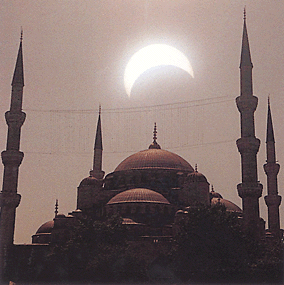Australians Watch Last Total Solar Eclipse Until 2015
Thursday, November 15th, 2012November 15, 2012
Sky watchers along the northern coast of Australia lined up this week for Earth’s last total solar eclipse until 2015. The eclipse began on November 14 just after dawn (local time there). The event was visible from slivers of Australia’s Northern Territory and state of Queensland, as well as a large, empty stretch of the Pacific Ocean, including the Coral Sea.
The path of the eclipse was far from any large cities. However, tens of thousands of people set up along the Australian coast to get a glimpse of the rare and beautiful event. Still more people took to the ocean on boats and ships to view the spectacle. The last total eclipse on Earth was about two years ago. A partial eclipse was visible across much of the South Pacific, including New Guinea and New Zealand, and parts of South America.

The moon moves to cover the sun during a solar eclipse, above the Blue Mosque in Istanbul, Turkey. (AP/Wide World)
An eclipse is created when the moon passes in front of the sun, blocking the sun’s light from reaching Earth. The event occurs rarely in any given area of Earth. But it occurs someplace on Earth every few years. During an eclipse, the outer atmosphere of the sun, called the corona, can be seen. The corona is hundreds of times as hot as the surface of the sun. An eclipse is beautiful to witness but can be dangerous. Direct sunlight is very powerful and can damage the eyes if viewed for any amount of time.
The next total solar eclipse will occur in March 2015 and will be visible in the North Atlantic region, including Norway’s Svalbard islands. A partial eclipse will occur in parts of Africa and the Atlantic Ocean in November 2013.
Additional articles in World Book:
- Baily’s beads
- Astronomy (1923) (a Back in Time article)
- Astronomy (1955) (a Back in Time article)
- Reading the Sky: Early Places of Astronomy (a Special Report)


